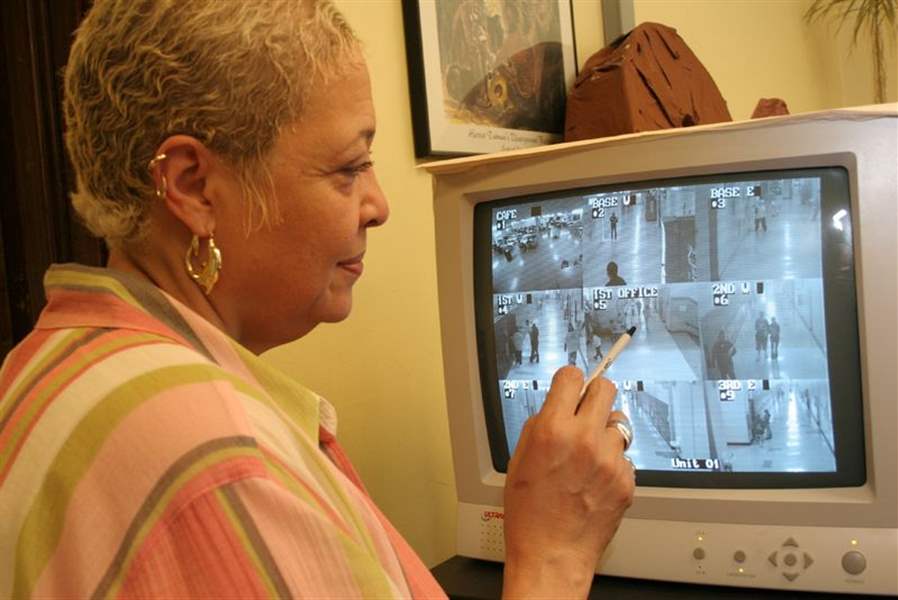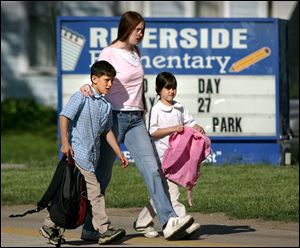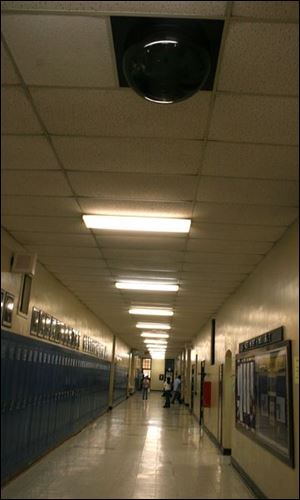
Where are the cameras? Parents want to know
5/29/2005
Pamela King, principal of Jones Junior High School, views nine images at once, each from a different camera. She says her students behave better knowing that their actions are observed.
long / blade

Pamela King, principal of Jones Junior High School, views nine images at once, each from a different camera. She says her students behave better knowing that their actions are observed.
The report that a young man carrying two guns had briefly entered Riverside Elementary School in North Toledo last week raised questions for many concerned parents.
Why were some of the exterior school security doors unlocked? And why aren't there security cameras?
Toledo Public Schools, the region's largest district with just under 33,000 students, has cameras and security doors installed at all of its high schools and junior high schools.
But a review conducted by The Blade before the incident found Riverside among 20 elementary schools without a surveillance system. Some of those buildings, including Riverside, also lack security doors that can be opened with a buzzer from the main office.
District officials told the newspaper that they intend to phase in installation of cameras and security locks over the next several years. The financially troubled school system simply cannot afford to do the work all at once, they said.
Within hours of the Riverside incident, however, Dan Burns, Toledo Public's chief business manager, said cameras would be added to the school at 500 Chicago St. this summer.
And within 24 hours of the Riverside scare, during which no one was hurt, Mr. Burns said the timetable for having cameras and security doors with buzzers at all buildings has now been stepped up.

Laura Charles cautiously escorts her children, Anthony, 8, and Tayler, 6, to Riverside Elementary on Thursday, one day after a man carrying two guns was spotted in the building.
"We are adding them in," he said Thursday morning. "Right now I'm looking at all schools that don't have cameras and buzzers. All schools will have cameras by next year."
Most schools in northwest Ohio and southeast Michigan are well-equipped with security technology, but Stacy Keisser, who was among the 400 Riverside parents who rushed to the school to take their children home on Wednesday, said the measures should have been in place at every school already.
Killings at Columbine High School and other American schools, the Russian school massacre, and threats of terrorism in the wake of the attacks of Sept. 11, 2001, have made security a heightened priority at schools nationwide. Security experts say the increased use of school building surveillance in recent years has been a deterrent to crime and fights.
Roy Balentine of CameraWATCH Corp., a Jackson, Miss., company that specializes in school security, said security measures used to be one of the first things cut when financial budgets ran tight, but that has changed.
"Over the last couple of years, we have seen an increase in the number of schools that are installing security measures," Mr. Balentine said. "We have seen that short transition to where security remains on their list of priorities more often."
Larry Sykes, president of the Toledo Board of Education, said the cash-strapped school system will be hard-pressed to install cameras everywhere. He cited the failure of a five-year, 2.5-mill tax levy earlier this month, which school leaders called a "substitute" for an existing levy. The measure went down with more than 71 percent of voters saying no.
"That money would have gone to pay for things like cameras," Mr. Sykes said.
School principals who do have surveillance in their buildings laud the technology.
"We know when children misbehave, they usually do it in groups," said Pamela King, principal of Jones Junior High School in South Toledo. "So we can always freeze that section of the camera and identify the people who are participants and who are the spectators."

A hallway at Jones Junior High School is monitored by a ceiling-mounted video camera housed in a plexiglass bubble. The school is equipped with eight surveillance cameras.
More importantly, she said the system can help school staff identify a threat or later be used as evidence.
Surveillance footage played a big role last year in prosecuting a Toledo man who abducted a third-grade girl from the parking lot of Stewart Elementary School on Avondale Avenue. Prentiss Anderson, 65, of 1348 Lincoln Ave. was sentenced to four years in prison for the abduction, which was captured on a school video camera.
Jones Junior High is equipped with eight security cameras that record movement in hallways and parking lots. Like her counterparts at other schools, Ms. King can watch video feeds from any of her school's cameras directly on her desktop computer.
"It helps children with their general behavior when they think the eye is watching, plus we can see who is entering and leaving the building," she said.
Toledo Public's high schools have many more cameras. The hallways at Rogers High School, for example, are watched by 23 cameras.
Since the district is involved in a $821 million reconstruction program to replace 57 buildings, eventually every school will have "total coverage," Mr. Burns said
The new elementary schools will have up to 36 cameras; middle schools will have between 36 and 48, and high schools will have as many as 80 cameras. All of the video feeds will be accessible from the district's administration building and even from a laptop with a wireless connection for police during an emergency.
The state is paying 77 percent of the cost for the new buildings, including the security systems.
"There will be no blind hallways, and we will be able to see each one," Mr. Burns said. "I don't think there will be any other schools around here doing that."
Kenneth Trump, president of National School Safety and Security Services, a Cleveland-based consulting firm specializing in school security, said installing cameras and alarm systems comes with a caveat. "Any type of equipment is a supplement to, but not a substitute for, a more comprehensive security plan," Mr. Trump said. "Cameras deter those who [can be deterred] and serve as evidence to those who are not. They are not a guarantee against an incident."
Jeff Dever, principal of Bowling Green High School, said it would be wonderful to have an absolute guarantee of safety, but he knows that's not possible, especially when educators consider the number of school shootings in recent years.
"Cameras are a deterrent, but we've used them in situations where there has been thievery, some incidents of vandalism. And out in the parking lot it helps - especially over weekends," Mr. Dever said.
The hurdle for many school districts in the past has been the cost, but many school leaders said security systems are now much more affordable.
Kelly Updike, a spokesman for the Leona Group of East Lansing, Mich., which operates six charter schools in the Toledo area, said only one of those schools has security cameras.
"Each school is autonomous, so if they decided that is something they would like to have, we work with them," Ms. Updike said.
Bernard Crawford, school leader at Toledo Accelerated Academy, a charter high school in Sylvania Township, said the building's dozen cameras are a huge comfort for parents.
"I think they are actually beneficial," Mr. Crawford said. "Our system saves video up to seven days, so if there was an incident, we could go back and look."
Perrysburg Superintendent Michael Cline said the suburban school district built its new high school in 2001 with $13,000 wrapped into the budget for cameras. The school does not have any internal cameras, but there are 16 cameras - two of which have night-vision technology - watching the perimeter of the building.
"I think surveillance and security predated Columbine. To the extent that you could prevent something like that, you would have to [incur] considerable expense in equipment and personnel," Mr. Cline said. "Trying to balance the need to provide a safe environment with cost is something we are always looking at."
Contact Ignazio Messina at: imessina@theblade.com or 419-724-6171.